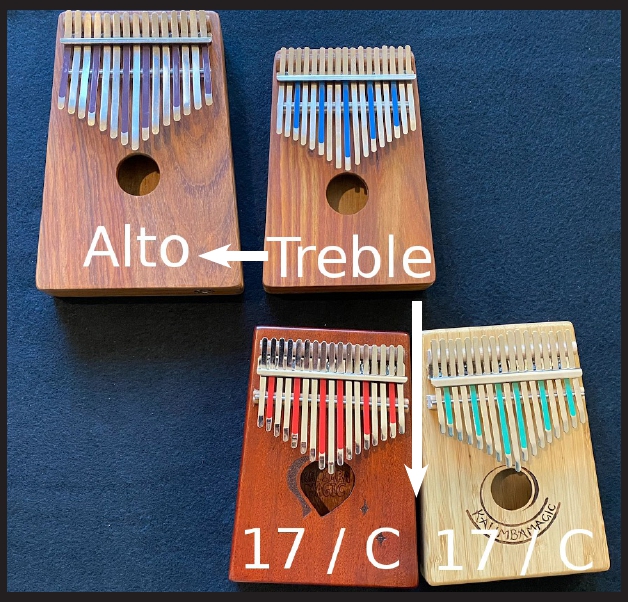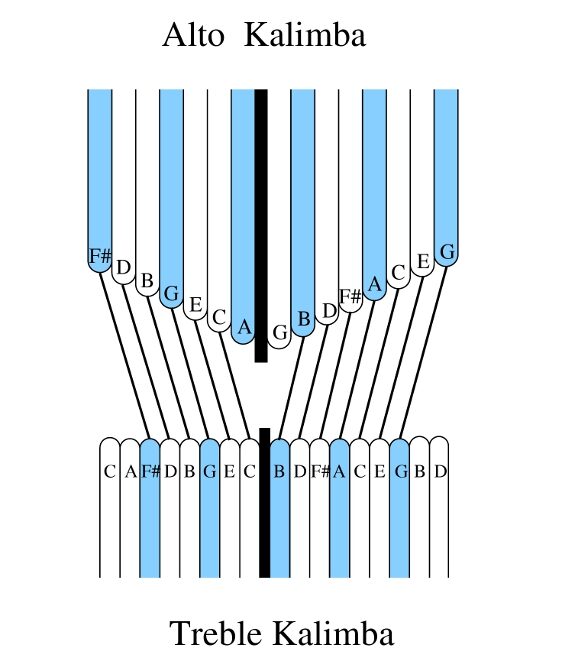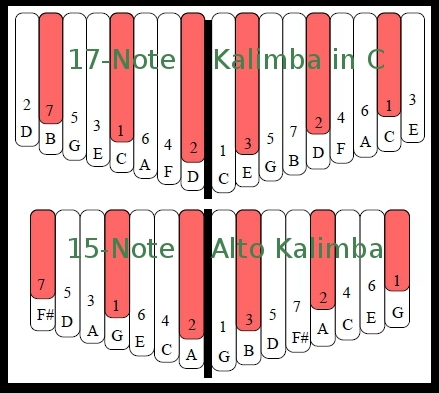
For starters, the Alto is bigger and lower, the Treble is smaller, and the 17-Note Kalimbas in C are the same size as the Treble kalimba.
In the beginning, there were many traditional types of kalimba, all over Africa. These inspired Hugh Tracey to create the Treble Kalimba, based on several design elements of various traditional instruments. In 1954, Hugh Tracey started selling the 17-Note Treble Kalimba commercially. These kalimbas set the standard for what a “kalimba” is – a modern version of the traditional African instrument.
When I asked Hugh’s son, Paul Tracey about it in 2005, he told me that the larger, lower 15-Note Alto kalimba was an afterthought, and that the “original” Hugh Tracey Kalimba was the 17-Note Treble.
If you look at the tuning chart below, you will see that the Alto Kalimba actually has a more logical note layout than the Treble Kalimba. The Alto, in the key of G, has G on the lowest note (the longest tine), and also G on the highest note (the shortest tine). It is perfectly book-ended by the key note, G. And, according to Paul, in Hugh Tracey’s mind, it was the perfect accompaniment instrument for the somewhat higher-pitched Treble Kalimba.

The Alto Kalimba’s notes.
The Hugh Tracey Treble Kalimba, with F#, is also in the key of G. However, the low note is B, the 3rd of G. I call this the “Silverbells” tuning – just sing the chorus to the secular Christmas classic “Silverbells”, and you are singing the notes from the bottom of this kalimba up.
The Treble Kalimba’s notes.
The Alto kalimba body tapers from 5.75″ wide at the foot to 5″ wide at the head. From head to toe it is just over 8″ tall, and the body is 1.5″ deep. The weight varies with the details of the wood, but the weight tends to be 13-14 oz.
The Treble kalimba body tapers from 5″ to 4.125″ wide. From head to toe it is just over 7″ tall, and the body is about 1.3″ deep. The Treble tends to weight 10-11 oz.
The Alto kalimba is larger because it plays lower notes. The size of a kalimba will determine the lowest “good sounding” note. You can make lower notes, but they won’t sound so good.
The larger Alto has 15 tines. The standard tuning ranges from G3 (G below middle C) to G5 (G below high C). The smaller Treble has 17 tines, from B3 (B below middle C) to D6 (D above high C).
The Alto kalimba is larger, but has fewer tines than the Treble. This is because the Alto kalimba uses 5 mm tines and the Treble kalimba uses 4 mm tines. Also, the Alto has more space in between the tines. If you have large thumbs, or if you are clumsy, or perhaps if you are a beginner, the Alto will require somewhat less thumb precision than the Treble. You may well experience the Alto to be easier to play than the tighter Treble.
Typically, people with larger hands prefer the Alto kalimba. People with smaller hands prefer the smaller Treble kalimba. People with small hands who are willing to move their thumbs a bit are fine with the Alto. People with small hands can also play the Alto kalimba resting on a napkin on a table surface. People with larger hands with high manual dexterity are fine on the Treble kalimba.
We do retune both Alto and Treble kalimbas in a dizzying array of specialized tunings. If you need to retune to a different key (usually required when playing with other instruments on songs in another key, or when singing with the kalimba), know that you can usually bring a tine down by 2 or 3 half steps, and you can raise the pitch of a tine by 2 or 3 whole steps. Learn more about tuning kalimbas.
People ask me “So, is my brand new 17-Note Kalimba a Treble, or an Alto?” Well, it is neither, but it is a hybrid. The size and shape of the instrument is entirely based on the Treble kalimba, but the tuning setup is more closely related to the Alto kalimba, only pitched in C rather than in G, an interval of a 4th higher.
I call these new kalimbas the “17-Note Kalimba in C,” which is a functional name that can be applied to a great many of the new kalimba models.
In the diagram below, note that the painted tines on the 17-Note Kalimba match the painted tines on the Alto kalimba. The number – ie, the degree of the scale – match on the two instruments. But the actual note names do not match.
Compare the Alto Kalimba to the 17/C Kalimba.

In the tuning chart, you can see the 17-Note in C has the 1 note, “C”, right in the middle as its low note. The Alto kalimba also has its 1 note, “G”, right in the middle. Anything you can play on the G Alto kalimba, you can play using the exact thumb strokes on the 17-Note kalimba in C… but it will sound higher in pitch. Similarly, anything you can play on the 17-Note in C (neglecting the top two tines) can also be played on the Alto kalimba.
Kalimba Magic paints the tines on the 17-Note in C the same way as the Alto to emphasize this basic similarity. And when you paint your kalimba tines in this way, the entire library of Alto Kalimba and “17/C” Kalimba materials are available for you to learn these instruments.
While most of the 17-Note kalimbas in C from other sellers tend to ship unpainted, many makers suggest that you paint them with a 5-painted tine system. Kalimba Magic will paint in this system if you request it… though to me, it indicates that it should be a “Treble Kalimba” with the 3rd (B) in the low tine.
And there is one more comparison to make:
Compare the Treble Kalimba to the 17/C Kalimba.
Here are some more blog posts that will be helpful to your kalimba understanding:
The Kalimba, its African History, and Black Pride – Your “Rough” Guide


Sign up for our newsletter and free resources with your email address:
We pinky promise not to spam you and to only send good stuff.
 Christmas in July 2025
Christmas in July 2025 Patriotic and American Music for Kalimba
Patriotic and American Music for Kalimba